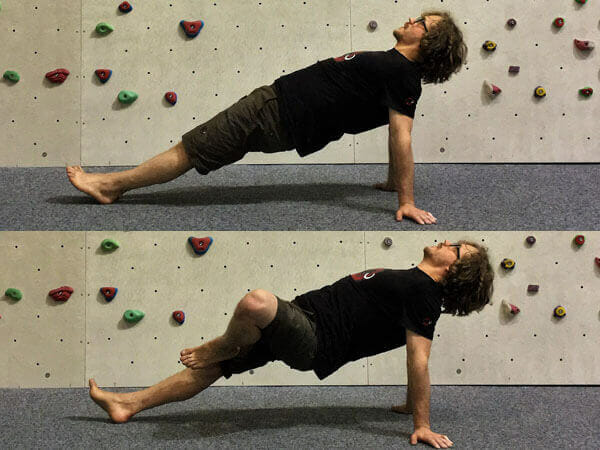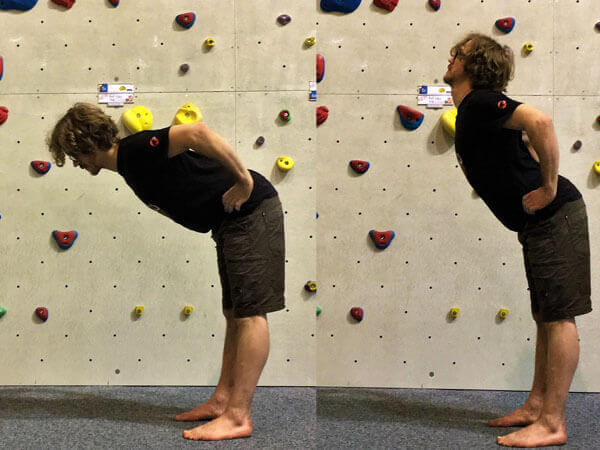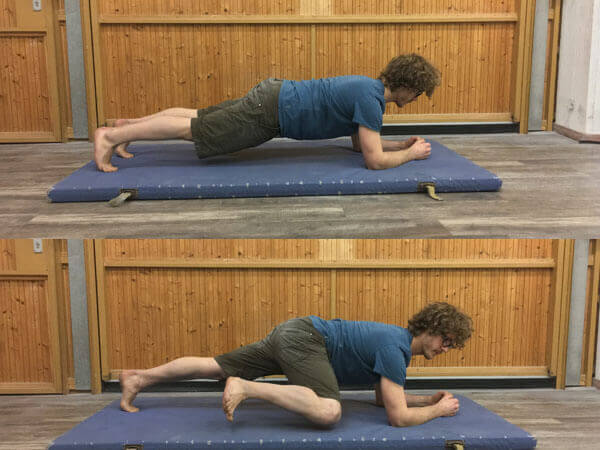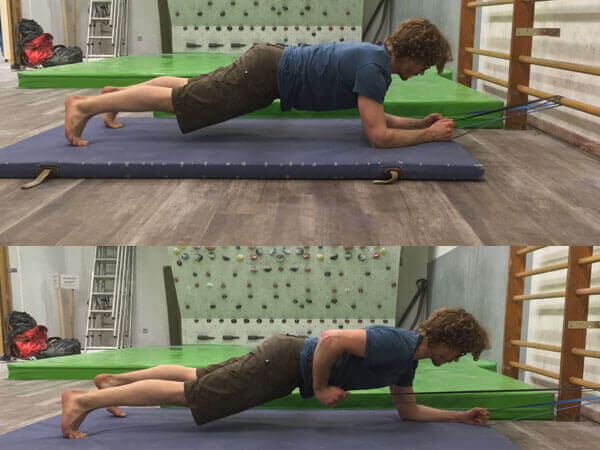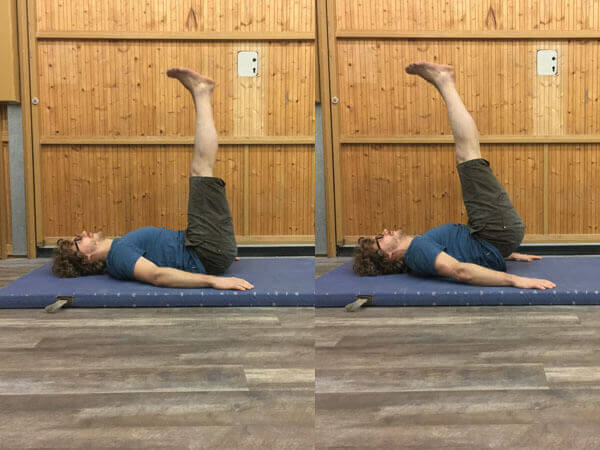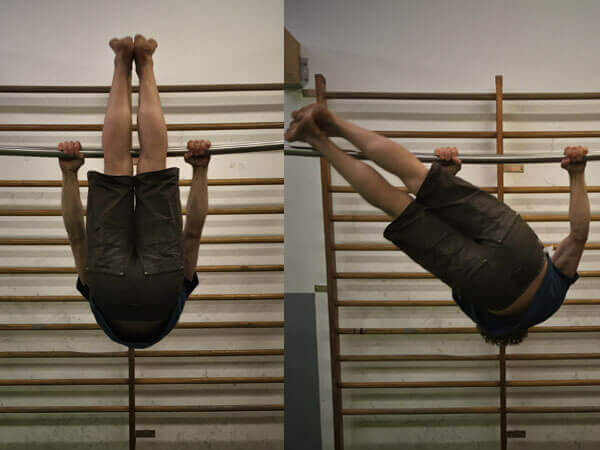Enough strength is a condition that does not exist!
The problem is that people often only work on the obvious weaknesses. Your fingers aren’t gripping well enough so get to the finger board to strengthen the annular ligaments. You didn’t manage the lock-off on the last boulder? So off with you to the pegboard to work on your biceps. At the end of a tough bouldering session, you’re also giving it your all on the campus board. For the last ounce of body tension, you’re torturing yourself in the plank position for 5 minutes. Even if you call this training, it’s not really training.
In this blog, I don’t want to discuss the general structure of training but focus much more on a less obvious weakness.
Core exercises to ensure more success during climbing
It’s actually remarkable how much our torso muscles – also known as the core – can contribute to a successful climb. As the connection between the legs and the arms, the abdominal core transfers strength to the extremities. In a less favourable resting position, for example, strong core muscles can relieve the hands using power transfer from the legs to the upper body. With good body tension, sloping footholds can be loaded more efficiently. At the same time, it’s easier to catch a slipped foot and return it stably to the foothold. Climbers who manage this, advance with such flowing movements that make the route look like a walk in the park.
The most frequently used core strengthening exercises include:
- Forearm plank
- Sit-ups
- “Windscreen wiper”
- Front Lever – for the very brave
What a standard plank and sit-ups have in common is that they primarily work on the rectus abdominis muscles, i.e. the straight abdominal muscles. But a strong core needs more than that. With the windscreen wiper, we also engage other muscles groups. But this exercise for the core is not easy and really something for those who are more experienced. The Front Lever is the ultimate challenge when it comes to core training. Only very few people can actually perform it properly. These exercises for core muscles really make demands on the abs but their antagonists are barely subjected to any strain. This refers to the back extensor muscles, which the exercise known as “Superman” targets. But simply performing the “Superman” exercise day in and day out can become quite boring and will eventually not have any training effect once the muscles get used to it.
What exactly are the core muscles?
Before starting with stomach muscle exercises, you should know some basics about the anatomy and function of the core. You may have heard the term “core muscles” and know that this refers to the muscles between the thorax and the pelvis.
Originally, the core was regarded only as the deep muscles around the spine. Their function is to keep the body stable in different positions. But with the shift towards new concepts, such as functional core training, and keeping traditional concepts like yoga and Pilates in mind, the term expanded to also include the outer torso muscles. Holistically considered, a stable posture doesn’t just depend on the deep muscles but is based on a complex interaction of co-ordination, stabilisation and strength involving all the core muscles.
The bony basic structure in the torso is the spine. It consists of 24 vertebral bodies which are connected via 23 gelatinous intervertebral discs. You can imagine it as a rod made up of many individual elements, allowing a high degree of mobility but actually being quite unstable by itself. That’s why the spine is stabilised by ligaments, muscles and connective tissue. In a neutral position, the deep muscles ensure the stabilisation of the spine which is fine-adjusted during movement. The outer part of the core muscles is primarily active during movement and ensures the dynamic stability of the spine.
Anatomy and function of the core muscles
Having explained what the core muscles actually are and how they consist of two parts, I’d now like to look briefly at the muscular elements and their function in this complex system.
The back muscles
Right on the spine, there are the deep back muscles made up of many small muscles that are attached to the individual vertebral bodies. These small muscles can align and stabilise the vertebral bodies very precisely. The outer back muscles consist of long muscle bands that connect several vertebral bodies. Together, these two muscle systems form one muscle group: the back extensor muscles (erector spinae muscles). As the name suggests, this muscle group is primarily responsible for extending/straightening the spine, but it’s also active during rotational movements.
The abdominal muscles
The abdominal muscles are a little more complex. They consist of three muscle layers on top of each other. They’re mainly not located directly on the spine but they’re connected to other abdominal muscles via tendons, thus forming a complete enclosure of the abdominal area.
The straight abdominal muscle (rectus abdominis muscle) forms part of the external abdominal muscles. It’s located at the front of the torso, creating the famous six pack with its intermediate tendons. Its task is to bend the torso. This can be done in quite a precise way, by “curling” the torso forwards vertebra by vertebra. The external oblique abdominal muscle (obliquus externus abdominis muscle) lies on top of the internal oblique and is the largest abdominal muscle. It’s active during bending of the torso and lifting the pelvis in particular.
During all torso movements, the abdominal and back muscles sometimes work together and sometimes in opposite directions, depending on the type of movement. All parts of the core muscles are engaged if the torso has to be held completely stable. In this case, the spine is supported as if by a corset, forming a fixed unit. If only one part is activated, the spine is rotated or bent, e.g. lifting the hips.
Then there are also certain muscle groups that are not directly associated with the abdominal muscles but support them during some torso movements. These include parts of the large back muscles of the upper body or the serratus anterior muscle just below the armpits. Some of the posterior leg muscles are also part of this. These muscles, too, can be trained with selected core body exercises.
How to build core strength
To make core stability exercises specific for climbers, the demands made on the core muscles during climbing must be clear. When considering the many movements during climbing, we can identify four patterns where muscles are subjected to strain:
- Rotation: preventing the torso from rotating externally, but also preventing rotation against the strength it exerts (internal rotation).
- Stability: static retention force to keep a body position stable e.g. during a resting position.
- Dynamic stability: static holding of a position while one or several extremities are moving, e.g. moving the feet into a different position, placing the feet on a foothold as quickly as possibly after a jump.
- Torso or hip flexion: bending the torso while the upper or lower extremities are firmly planted on a wall. This includes the bat hang or trying to reach a very high foothold.
How to strengthen the stomach muscles for this
The following includes a selection of the best core strength exercises specifically for climbing. Climbing requires you to co-ordinate all body parts during the specific situations. That’s why it makes sense to choose free forms of exercises. That means several muscle groups have to be engaged and controlled at the same time. A contrast would be strength training with equipment, as you may do at a gym. This usually works on one muscle in isolation.
I will therefore describe free methods for how to strengthen the core here. For one set of exercises, you should always perform a certain number of repetitions. After each set, take a small break, ideally 1 to 3 minutes. The length of the recovery will vary for each person and depends on fitness.
Try to work out for yourself what the shortest time is you need for a rest so you can still manage to do all the repetitions in each set. As your fitness improves, this time should reduce while maintaining the same intensity. You can also try a harder variation as soon as you notice that the easier exercise is no longer challenging. In addition to these good core exercises listed here, the options for strengthening the abdominals are practically limitless. So with a bit of research, you can really create some variety in your training.
Core exercises for the back extensor muscles
Superman (beginner)
Target area: back extensor muscles and posterior leg muscles – also known as the posterior chain.
How to do it: lie on your stomach and stretch out your arms and legs (top picture). Look a short distance ahead and down. Lift one arm and the opposite leg as high as possible (bottom picture). Hold this position for about 1 second before returning to the starting position. Then repeat with the other arm and the leg opposite to that.
Intensity: 20 repetitions make up one set. Do three sets in total with a break of about 1 to 3 minutes in between.
Reverse Climber Plank (beginner)
Target area: anti-rotation and co-ordination of the posterior chain.
How to do it: facing the ceiling, support yourself on your hands with arms straight directly under your shoulders. Also stretch out your legs so your entire weight rests solely on your hands and heels (top picture). In this position, lift your right foot and angle your knee so your heel almost touches the knee of the other leg (bottom picture). Then return to the starting position. Do the same with the left leg.
Intensity: 4 to 10 repetitions per leg make up one set. Do another set after a break of 1 to 3 minutes.
Important: make sure to keep your arms and body straight during this exercise. Focus on engaging the legs, buttocks and the back muscles.
Back Stretcher, standing (beginner)
Target area: the back extensor muscles
How to do it: stand with your feet shoulder-width apart, knees slightly bent. Bend your upper body forwards to about 30°. Now curl your spine down vertebra by vertebra, slowly exhaling during this movement (picture on left). This creates a round back but make sure not to use the hips. Then push your chest up as high as it will go whilst inhaling. You now have a hollow back and this concludes one repetition (picture on right).
Intensity: repeat this movement 20 times and do another set after a break of 1 to 3 minutes.
Important: the movement must only involve the back. You might be using your hips without noticing. So really focus on the execution and check in a mirror if you can.
Back Stretcher, standing with resistance (advanced)
Target area: the back extensor muscles
How to do it: you can make this exercise harder by using a resistance band. You can use a climbing hold, for example, to attach the band. Perform the exercise as described above but your arms hold on to the resistance band at a slight angle from your body.
Intensity: repeat this movement 20 times and do another set after a break of 1 to 3 minutes.
Side note
In addition to these exercises for building the core, you can also work on all your extensor muscles using free weights, doing deadlifts, for example. These exercises, however, are very complex and can put a lot of strain on the locomotor system. To learn them, I’d recommend a core training course with an expert.
Stomach muscle exercises
Climber Plank (beginners and advanced)
Target area: straight and oblique abdominals
How to do it: the starting position is the plank with bent arms and elbows directly under the shoulders (top picture or version for beginners). If you already know the standard plank and can hold it for longer than a minute, I recommend the next level of difficulty: lift your right leg and try to guide the knee towards your elbow. Hold this position for the duration of one breath, then return your leg to the starting position (bottom picture). Do the same with the left leg.
Intensity: perform one set with up to 10 repetitions per leg for beginners and up to 25 repetitions per leg if you’re advanced. The break between sets should be about 1 to 3 minutes.
Important: try to keep your body straight the whole time during this exercise, with your hips moving as little as possible. You can check in a mirror or ask someone to record you.
Plank Pull – resistance band (advanced)
Target area: in addition to the straight and oblique abdominals, this exercise also works on parts of the arm and back muscles.
How to do it: for this exercise, you need to be able to attach a resistance band close to the floor. The starting position is the plank but you’re also holding one end of the resistance band in each hand (top picture). Using your right arm, pull the band alongside your body towards the hips, then return to the starting position (bottom picture). Do the same with the left arm.
Intensity: 10 to 20 repetitions make up one set. Perform another set after a break of 1 to 3 minutes.
Important: keep your hips static as much as possible.
Exercises for the rectus abdominis muscle
Crunches
Target area: upper part of the rectus abdominis muscle
How to do it: lie on your back with your knees bent and soles of the feet on the floor. Now push your feet into the floor a little and engage your buttocks. This activates the antagonist of the hip flexor muscle, preventing it from contracting, which is also known as reciprocal inhibition. You can cross your arms in front of your chest or position them slightly to the side of your head – as if putting on headphones – to make the exercise a little harder (top picture). While exhaling, lift your shoulders off the floor and slightly curl up your upper body. Only lift your upper back off the floor. The lower part of your back must stay on the floor (bottom picture). Then lower your shoulders back to the floor, whilst still bracing your abdominal muscles. Try to keep your head in one line with your back and make sure you don’t pull on your head with your hands.
Intensity: just do as many repetitions as you can. This exercise is great for working on the local endurance of your rectus abdominis muscle. Take a break of 1 to 3 minutes.
This exercise is not the most important for climbers but it helps with developing basic local endurance. You may know the classic sit-ups where you tuck your feet under a fixed point so you can bend all of your upper body. However, this exercise doesn’t just engage the abdominal muscles but also a large part of the hip flexor muscle. This is not how we want to target the rectus abdominis muscle. It’s better to do crunches.
Leg Lifts, lying down (beginner)
Target area: lower part of the rectus abdominis muscle
How to do it: lie on your back with your arms loosely by your side. Now lift your straightened legs up so they form almost a 90° angle with the floor (picture on left). Try to lift your buttocks off the floor by curling your abdomen towards your head (picture on right). Then slowly return your buttocks to the floor again.
Intensity: repeat this movement 10 to 20 times, then take a break of 1 to 3 minutes.
Again, make sure the hip flexor muscle isn’t involved in the movement so the abdominal muscles get the best out of this exercise.
Hanging Knee Lifts or Leg Lifts (advanced)
Target area: lower part of the rectus abdominis muscle
How to do it: on a pull-up bar, position your arms a little further than shoulder-width, actively engaging your shoulder muscles. Imagine you’re trying to bend the bar. Lift your knees upwards with your hips at an angle of 90°. This is the starting position. From the starting position, curl up your hips as much as possible. Then slowly return to the starting position.
Intensity: try 6 to 12 repetitions and take a break of 1 to 3 minutes before the next set. As soon as you’re able to perform 3 sets with 12 flawless repetitions, you can stretch out your legs in front of you. Extending your levers makes this exercise more challenging. Make sure you’re not swinging during this exercise.
This exercise is performed whilst hanging from a pull-up bar. That’s why it requires some shoulder strength to prevent being in a damaging position. Co-ordination is also a little more challenging because you have to# focus on several aspects at the same time (shoulders engaged + strong core).
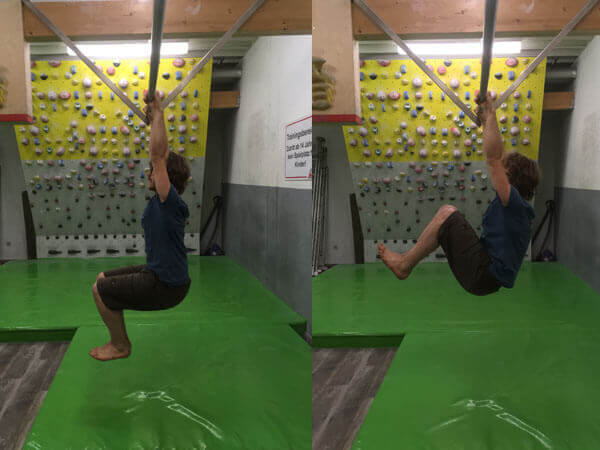

Roll-down using slings or rings (advanced)
Target area: rectus abdominis muscle, hip muscles and parts of the arm and chest muscles
How to do it: adjust the handles of the slings so they’re at hip height when you’re kneeling. The handles should be about 30 cm away from you. Hold on to them with straight arms (Step 1). Create body tension from your hips to your shoulders and move your arms forwards until they almost form a line with your body (Step 2). Hold this position for the duration of one breath (2 seconds). Actively move your arms back into the starting position. Make sure to maintain body tension.
Intensity: do 6 to 12 repetitions and 2 to 3 sets with a break of 1 to 3 minutes in between.
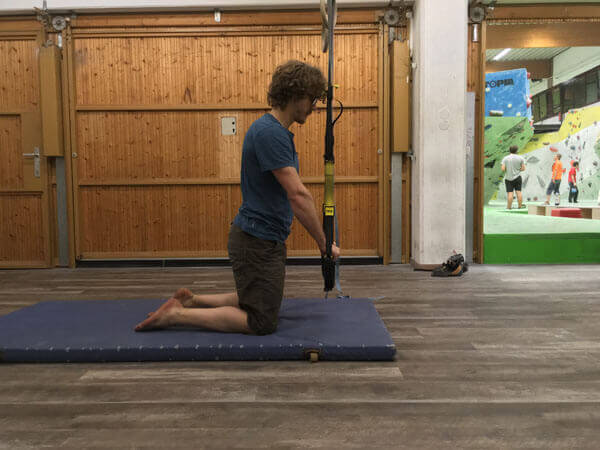
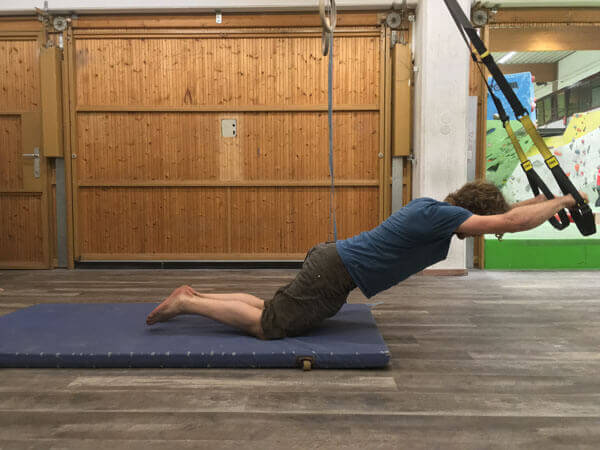
The best core exercises for the straight and oblique abdominals (rotation)
Standing anti-rotation with a resistance band (beginner)
Target area: rectus abdominis muscle and obliques, parts of the back extensor muscle
How to do it: for this exercise, you need to be able to attach a resistance band at about chest height. Hold on to the other end of the band with both hands and, side-on, stand far enough away from the attachment point that you can hold on to the band with straight arms. The pulling force should be high enough to challenge you but not so high that it interferes with your balance (picture on left). The objective now is to raise the band with both hands and back into the starting position without losing tension (picture on right). Shoulders and hips should remain in one line.
Intensity: 10 repetitions make up one set. Do 3 sets with a break of 1 to 3 minutes in between.
Hanging “Windscreen Wiper” (advanced)
Target area: rectus abdominis muscle and obliques, parts of the back extensor muscle, shoulder muscles
How to do it: the starting position is similar to the Hanging Leg Lifts. Only now you have to lift your legs such that your back is almost parallel to the floor (picture on left). Alternatively, you can bend your arms. In this position, move your legs from side to side like a windscreen wiper (picture on right).
Intensity: try to do 6 to 12 repetitions. Whenever your legs return to the starting position, you’ve completed one repetition. Do another set or two after a break of 1 to 3 minutes.



